- Joined
- Dec 29, 2012
- Messages
- 394
Hi all friendly hobby machinists of the forum,
I use 5'' chuck on my 7X12 on a backplate I made on my lathe the easy way!
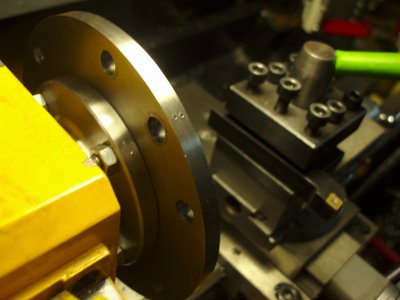
Backplate was made from a 15mm thick old iron base of a microphone stand!!
I cut it to an approximate hexagon, drilled it at center, made another 4 holes (using a paper pattern) to mount it directly on the lathe spindle and machined the following:
The 125mm diameter periphery
on the one side a 55mm diameter recess to mount the plate on the spindle.
Next I turned it around and machined the 95mm recess required to enable my lathe to accept a 125mm (5”) chuck.
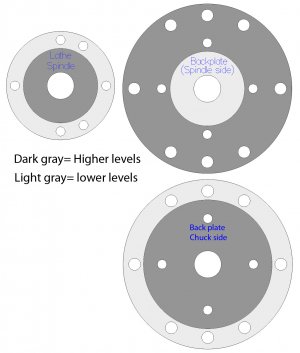
It took time and patience to machine all that iron but the results were rewarding
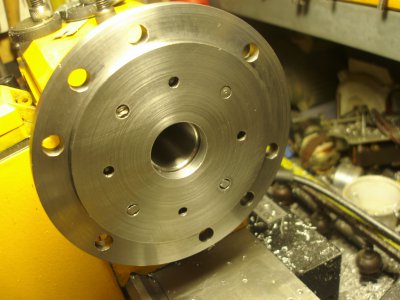
Next I had to drill holes both for 3 jaw (3 holes) and for 4 jaw chuck (4 holes).
To avoid balancing problems, as you can see I also made symmetrical holes opposite to the ones needed (see next photo).
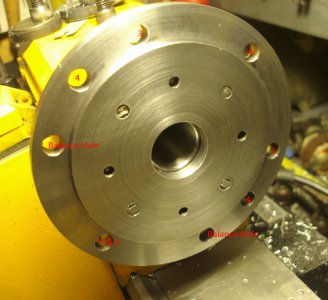
The goal was to make sure the weight was even around the axle of the backplate to avoid serious vibration. With the 3jaw chuck on the backplate I have practically no vibration. With the 4 jaw chuck is a different story as the chuck is only balanced when I remove the jaws or when I center a piece using the DTI.
My back plate was ready to support the 5" (12,5 cm) cheap 3 and 4jaw chucks I bought from Chronos.
http://www.chronos.ltd.uk/acatalog/chinese_lathe_chucks.html
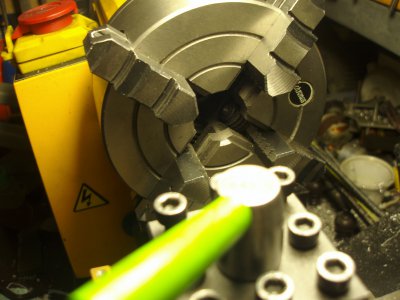
If you think that is a lot of iron mass for the little 7X12 and the Chinese bearings, You are absolutely right!!!
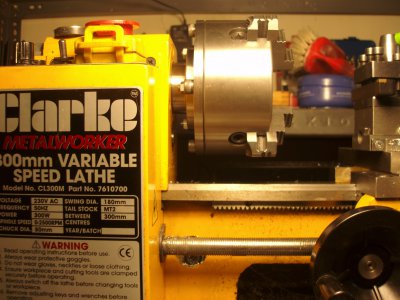
In comparison to the humble 3” chuck my lathe had, the new ones are monsters.
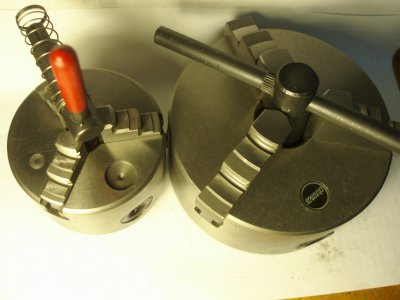
Why I did it then?
I must confess that I have changed the Chinese ball bearings of the spindle to taper roller bearings. The main reason for that was not to support heavier chucks but to improve accuracy on the lathe. A pair of SKF 30206 taper roller bearings, at a cost of 25 Euros, significantly improved the performance of the lathe. I am not expert on the subject but as they are used for heavy loads, like car wheels, I think they can handle much more metal than a 5" chuck.
At the photo below you see the old bearings and the packages of the taper roller ones.
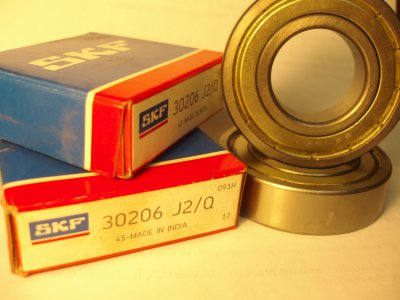
Verdict:
Pros
Lathe looks and feels, less like a toy as before (and I feel more like a small machinist)
Can hold larger items for machining
Easier change of chucks as the back bolts, although larger, are accessible now
Chuck key is no longer lost as it is big and clearly seen
The Bigger chuck works like a flywheel on a steam engine, it stores rotational energy. (It has a significant moment of inertia and thus resist changes in rotational speed). In plain English it is harder to stop a big rotating mass with a small lathe tool. An advantage for such a small lathe with a 350W motor.
Cons
If jaws protrude more than 1.18’’ inch (30mm) from the chuck they hit the lathe bed (don’t ask how I know it)
It takes considerable time for the chuck to come to a halt when you switch power off
My personal feeling?
I like it a lot!
I think that every euro I have spent on the bearings and the 125mm chucks was well spent and I enjoyed every second on making it.
Since this mod I only use the “big” 4 jaw chuck even for small work as I can center with an accuracy of 0,1mm everything and work on it.
Thank you for reading this
Petros








I use 5'' chuck on my 7X12 on a backplate I made on my lathe the easy way!

Backplate was made from a 15mm thick old iron base of a microphone stand!!
I cut it to an approximate hexagon, drilled it at center, made another 4 holes (using a paper pattern) to mount it directly on the lathe spindle and machined the following:
The 125mm diameter periphery
on the one side a 55mm diameter recess to mount the plate on the spindle.
Next I turned it around and machined the 95mm recess required to enable my lathe to accept a 125mm (5”) chuck.

It took time and patience to machine all that iron but the results were rewarding

Next I had to drill holes both for 3 jaw (3 holes) and for 4 jaw chuck (4 holes).
To avoid balancing problems, as you can see I also made symmetrical holes opposite to the ones needed (see next photo).

The goal was to make sure the weight was even around the axle of the backplate to avoid serious vibration. With the 3jaw chuck on the backplate I have practically no vibration. With the 4 jaw chuck is a different story as the chuck is only balanced when I remove the jaws or when I center a piece using the DTI.
My back plate was ready to support the 5" (12,5 cm) cheap 3 and 4jaw chucks I bought from Chronos.
http://www.chronos.ltd.uk/acatalog/chinese_lathe_chucks.html

If you think that is a lot of iron mass for the little 7X12 and the Chinese bearings, You are absolutely right!!!

In comparison to the humble 3” chuck my lathe had, the new ones are monsters.

Why I did it then?
I must confess that I have changed the Chinese ball bearings of the spindle to taper roller bearings. The main reason for that was not to support heavier chucks but to improve accuracy on the lathe. A pair of SKF 30206 taper roller bearings, at a cost of 25 Euros, significantly improved the performance of the lathe. I am not expert on the subject but as they are used for heavy loads, like car wheels, I think they can handle much more metal than a 5" chuck.
At the photo below you see the old bearings and the packages of the taper roller ones.

Verdict:
Pros
Lathe looks and feels, less like a toy as before (and I feel more like a small machinist)
Can hold larger items for machining
Easier change of chucks as the back bolts, although larger, are accessible now
Chuck key is no longer lost as it is big and clearly seen
The Bigger chuck works like a flywheel on a steam engine, it stores rotational energy. (It has a significant moment of inertia and thus resist changes in rotational speed). In plain English it is harder to stop a big rotating mass with a small lathe tool. An advantage for such a small lathe with a 350W motor.
Cons
If jaws protrude more than 1.18’’ inch (30mm) from the chuck they hit the lathe bed (don’t ask how I know it)
It takes considerable time for the chuck to come to a halt when you switch power off
My personal feeling?
I like it a lot!
I think that every euro I have spent on the bearings and the 125mm chucks was well spent and I enjoyed every second on making it.
Since this mod I only use the “big” 4 jaw chuck even for small work as I can center with an accuracy of 0,1mm everything and work on it.
Thank you for reading this
Petros








Last edited:

